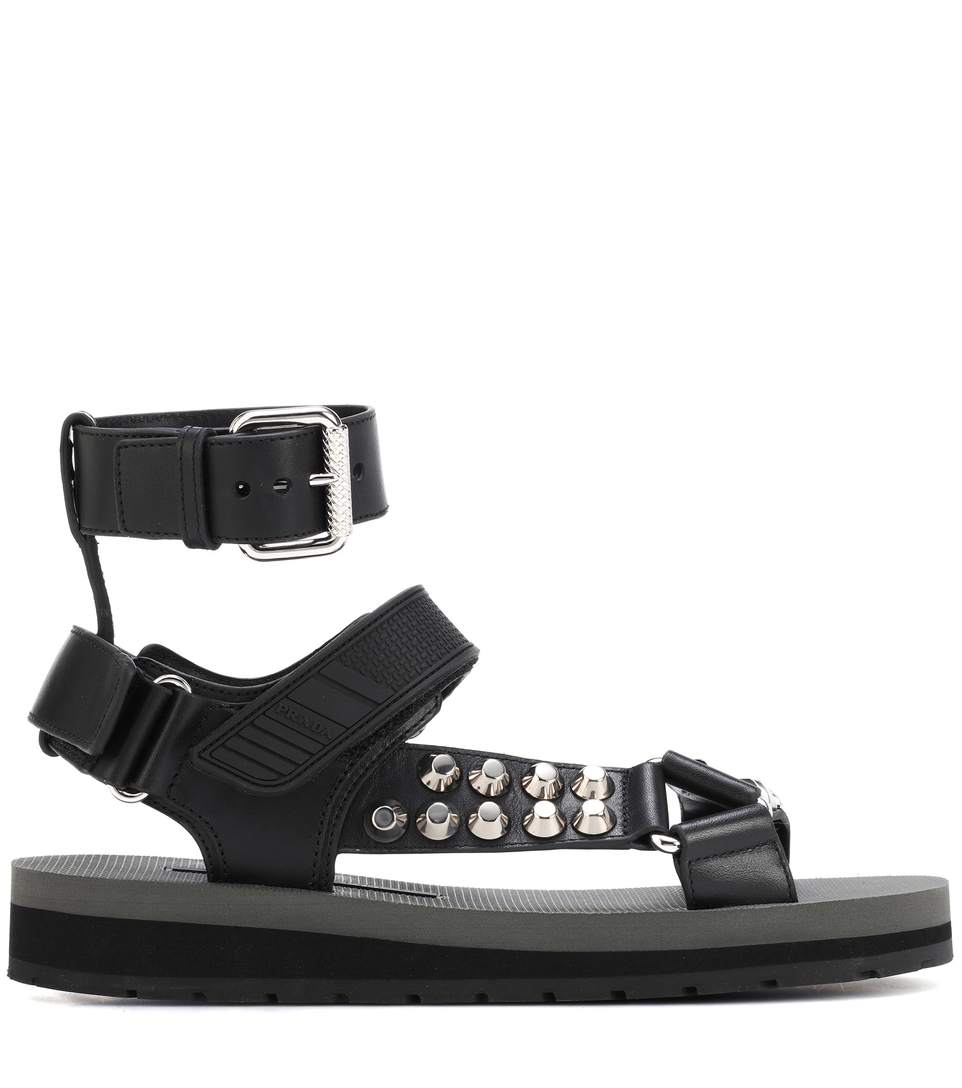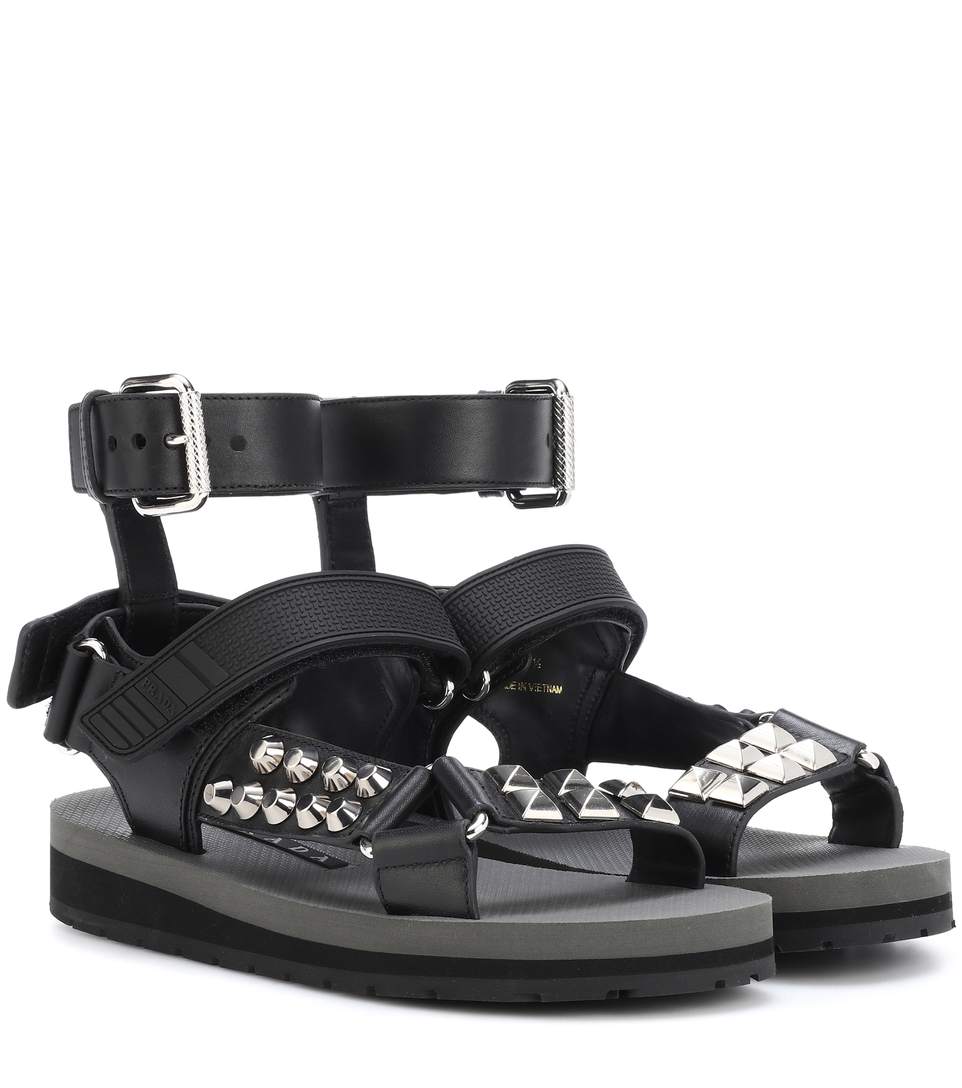

As we advised you on the heels of this S/S 2014 runway shows, the classically sport-centric sandal — for that Teva is famous — was making its way on the runway, albeit without any official involvement in Teva in almost every instance. High fashion adoption of sporty sandals came with a massive array of style books referring to the footwear fashion — which was utilized by Prada, Chanel, Alexander Wang, Marc Jacobs, and other big names in recent season — as “Tevas,” “Teva-like,” “Teva-esque,” and so on.Such usage of the Teva name is problematic from a trademark perspective (more about that in a moment), although it has not shown to be a point of contention for Teva. It could prove confusing for consumers, and Saks Fifth Avenue has apparently taken it a step farther for S/S 2017. After demonstrating what the fashion media called a bejeweled “Teva-like” sandal for S/S 2014, Prada introduced an even closer replica of Teva’s classic Weapon for S/S 2017. Consumers are now able to get their hands on the sandals — via pre-order, naturally — for $545 from Neiman Marcus, Bergdorf Goodman, Saks Fifth Avenue and co.Saks Fifth Avenue’s offering shows especially interesting, as unlike all of the others selling the shoes, Saks explicitly lists the fashion as “Teva Strappy Grip-Tape Sandals,” which presents the question: Does a formal Prada x Teva collaboration exist?

Not only a useless exercise targeted, this type of unauthorized uses serves a very specific point. To protect against the genericization and thus, undoing of a trademark’s degree of distinctiveness. In practice, manufacturers oftentimes attempt to stamp out others’ use of its title as a descriptive word so as to make sure the potency of their signature remains undamaged. Otherwise, the mark becomes worthless in its own function of identifying a source of goods/services. That is really where Teva comes from. The expression Teva is used by fashion editors, advertisers, copywriters, bloggers, and today retailers as the name of a product (including the Prada sandals and many others that comprise of “webbing upper, hook & loop closure, universal strapping system, EVA footbed, and durabrasion rubber outsole” or any combination thereof) as opposed to identifying an exclusive origin of the product.The truth that Teva is being used not as a signature but as a descriptive word to categorize a new style of sandals could have severely unpleasant impacts on the term’s status as a distinctive indicator of origin. In addition, if at hand, it might function to seriously confuse consumers about what — they’re buying.While such use of their Teva trademark with no authorization, particularly in the case of Saks Fifth Avenue, almost definitely amounts to trademark infringement (Teva has an arsenal of federally registered trademarks for its name), what about the design of this Prada sandal? Is the sandal, itself, legitimately debatable? That isn’t completely unlikely, as Teva does, after all, keep a minumum of one layout patent and utility patent in connection with its classic sandal design.


The brand’s site claims it invented the contoured footbed from the 1930s — and it stands behind its anatomically designed, suede-topped footbeds with heavy, cradling heel cups, four posture-enhancing arches, and a raised toe bar. The buckles on both straps are adjustable so that you may find a secure fit. 1 enthusiastic reviewer who has worn out the style to Disney World and National Parks such as Zion and Bryce Canyon stated, “Nothing rubs, there’s absolutely not any break-in demanded… I can not endure a thong between my first and second toe, but with them, you can’t even feel it. I really hope they never remove this fashion.” If your heart is set on a more fashion-forward slide, then you do not have to sacrifice support. Beek has figured out a way to mold a raised arch to its all-leather sandals with no bulky appearance that generally includes it. Developed by artisans in Mexico, their shoes are made to survive. We are to the Finch silhouette because the top strap positioning isn’t merely a unique style but one that is designed to hold your foot securely in place after walking. Finding sandals that will hold up over time is difficult enough. Detecting a pair that you’re able to live in that will not fall off your feet, give you depart from your arches unsupported — oh, which also seem cute — is a much taller order.While vases are found at sites other than Fort Rock Cave, no other site has generated the odd quantity found at Fort Rock. They vary from child-size to large adult size. Most are broken or worn, which suggests they have been lost rather than being stored for subsequent use.

Early Greek vases were made from a stiff leather or wooden sole to which leather straps were attached. These straps usually went involving the wearer’s big toe and second toe and around the rear of the ankle to maintain the only firmly to the base of the foot. Much of the individual design of these sandals was created by the different ways the leather straps wrapped around the foot and ankle. Wealthy people wore soft leather sandals, occasionally dyed in various colours. The very wealthy occasionally even had gilded sandals, or vases painted gold, in which the leather was coated with gold. Some high officials and stage actors wore sandals known as buskins, with tall bottoms made of cork, which made them appear taller. Some shoemakers carved designs or placed nails in the soles of the sandals in a variety of patterns, so the footprints of their wearer left a distinctive mark. 1 pair of ancient Greek sandals was found that abandoned the words “Follow me,” composed in each footprint, and many experts think that the shoes must have belonged to some prostitute. Workers wore heavy handed sandals, like the thick leather crepida, which were created with an extra-large sole and wrapped around to guard the sides of the foot, then laced the top.Shoemakers became respected citizens at the Greece of the fifth and fourth centuries b.c.e., and their craft was believed to be viewed over by the god Apollo–god of sunlight, music, poetry, and recovery, among others.
It doesn’t appear so — at least not according to reps for Teva (and the giveaway lack of any Teva branding connected with the actual Prada sandals themselves), but also the newest – unlike others – also does not seem to be too overly troubled by the marginally flagrant and widespread utilization of its name because a descriptive term.Consider Chanel, as an example. The Paris-based brand’s legal counsel began cracking down on unauthorized use of its trademarked name years back. The Paris-based design house has made its position rather well-known. For several years, it has been carrying out full page advertisements in popular trade book, Women’s Wear Daily, for instance, to inform editors, journalists, bloggers, etc., of its own rights in the Chanel mark. The advertisement consistently includes the following language:A note of information and entreaty to style editors, advertisers, copywriters and other well-intentioned mis-users of our Chanel name: Chanel was a designer, an extraordinary woman who left a timeless contribution to fashion. Chanel is a cologne. Chanel is contemporary elegance in couture, ready-to-wear, accessories, watches and fine jewelry. Chanel is the registered trademark for fragrance, cosmetics, clothes, accessories and other amazing things. Though our style is justly famous, a coat is not ‘a Chanel jacket’ unless it’s ours, and someone else’s cardigans aren’t ‘Chanel for now.’ And even if we are flattered by such tributes to our fame because ‘Chanel-issime, Chanel-ed, Chanels, and Chanel-ized’, PLEASE DON’T. Our attorneys positively detest them. We take our trademark seriously. Merci, Chanel, Inc..

Sandals themselves were occasionally given magic powers in the myths of the moment. Although the gods and goddesses were often pictured barefoot, Hermes and Iris, the messengers of the gods, have been constantly pictured in winged sandals, and goddesses like Hera, the queen of the gods, and Aphrodite, goddess of beauty and love, were frequently depicted in gold sandals.Sandal, type of footwear consisting of a sole fastened to the foot by straps across the instep, toes, or ankle. The oldest known example of a sandal dates from approximately 10,900 years before the present, is made from sagebrush bark, also stems from what’s now the U.S. state of Oregon. Sandals also have been observed in ancient Egypt, where just important personages wore sandals. Egyptian vases were made of papyrus and other materials, including leather and wood. The ancient Greeks and Romans also wore sandals; the Greek god Hermes (known to the Romans as Mercury) is often portrayed with winged sandals. But, with the development of Christianity, sandals fell into disrepute, as church leaders thought sandals left women’s feet overly naked.In contemporary times, sandals have been extremely popular, particularly in warm climates. Together with the growth of mass shoe production, sandals have been produced in a variety of styles and materials–from the easy thong to the platform sandal. The expression sandal has also been used to refer to some woman’s low-cut shoe or mild slipper.You almost can not talk about comfortable sandals without Birkenstock coming up.
Prada returns to its ’90s roots with these urban-cool platform sandals. Designed with leather and rubber straps, the style is embelllished with conical and pyramid studs that infuse the look with rebellious attitude. Capture Prada’s penchant for unexpected juxtapositions, styling yours with dresses and skirts.
- upper: calf leather
- sole: fabric insole, rubber sole
- round open toe
- buckle-fastening ankle strap, VELCRO® fastening
- Designer colour name: Nero
- Fits slightly large to size – we recommend trying one half size smaller
- European sizes
- 2cm-1″ platform
- 3cm-1″ wedge heel
open size chart
It does not seem so — at least not according to repetitions for Teva (and the giveaway lack of any Teva branding connected with the actual Prada vases themselves), but also the newest – unlike many others – also does not seem to be too overly bothered by the somewhat flagrant and widespread utilization of its title as a descriptive term.Consider Chanel, for instance. The Paris-based brand’s legal counselor started cracking down on unauthorized use of its trademarked name years back. The Paris-based design house has made its place rather well-known. For many decades, it has been carrying out full page ads in popular trade publication, Women’s Wear Daily, for instance, to notify editors, journalists, bloggers, etc., of its rights in the Chanel mark. The ad consistently contains the following terminology:A note of information and entreaty to style editors, advertisers, copywriters and other well-intentioned mis-users of our Chanel title: Chanel was a programmer, an extraordinary woman who made a classic contribution to fashion. Chanel is a perfume. Chanel is modern elegance in couture, ready-to-wear accessories, accessories and fine jewelry. Chanel is our registered trademark for fragrance, cosmetics, clothes, accessories and other amazing things. Though our style is justly famous, a coat is not ‘a Chanel coat’ unless it is ours, and someone else’s cardigans are not ‘Chanel for now.’ And even if we’re flattered by such tributes to our fame because ‘Chanel-issime, Chanel-ed, Chanels, and Chanel-ized’, PLEASE DON’T. Our attorneys positively detest them. We take our trademark seriously. Merci, Chanel, Inc..